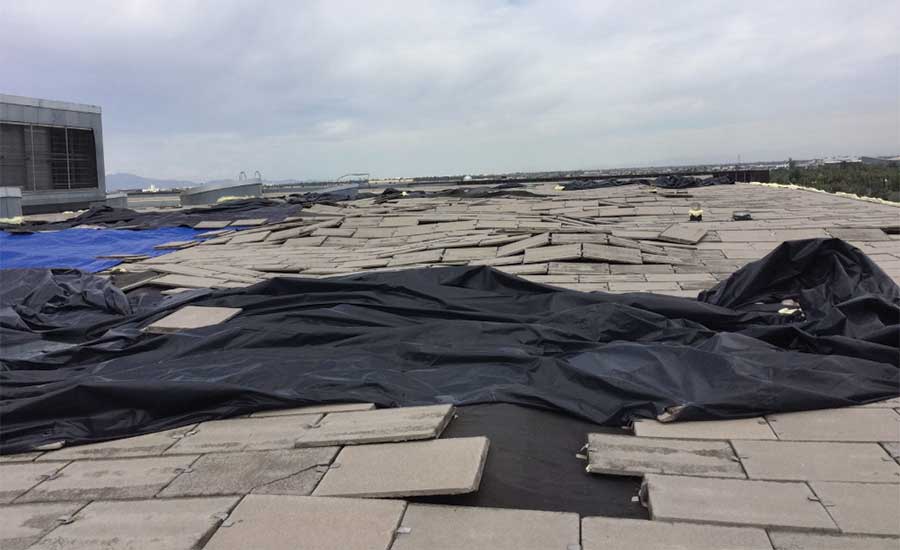The Burton Barr Library in Phoenix needs a new roof. As a monsoon swept through the downtown area in mid-July, a portion of the roof assembly lifted, setting off a chain reaction that led to the failure of a sprinkler system and extensive water damage.
Closed since July 16, the library is scheduled to reopen next summer, according to city officials. The break will allow contractors to replace the roof and fifth-floor sprinkler system and remediate the water damage. Repair costs are estimated at $6 million to $8 million. Brycon Construction is performing interior cleanup and cost estimates for water damage.
According to Wiss, Janney, Elstner Associates’ forensics report to the city, monsoon winds, estimated at 40 to 50 mph, lifted a significant portion of the northwest portion of the tensegrity roof, which allowed dust to enter the structure. John Duntemann, senior principal at Wiss, Janney, Elstner and one of the authors of the report, says the design wind speed was 70 mph when the library was built and 115 mph based upon Phoenix’s current building code.
Smoke alarms interpreted the dust as a fire threat, triggering a pre-action sprinkler system on the uppermost floor of the 300,000-sq-ft, five-story facility. The pre-action sprinkler system failed to contain the water, causing massive flooding throughout the library.
Pre-action sprinkler systems are filled with compressed air and typically are used in libraries and museums instead of wet, or water-filled, systems to prevent accidental discharge. “The air compressors for the pre-action system piping were not operational, but the means for system activation (the smoke detection system and the heat-activated sprinklers) and the water supply to the pre-action valves were in service,” the report states.
Although the wind uplift displaced and detached precast-concrete pavers and rigid insulation beneath the synthetic rubber membrane, the roofing assembly is “well-constructed from a water-tightness perspective,” the report says.
“Our review also includes determining if city policies and procedures were properly followed beforehand, and if not, what action should be taken,” according to an Aug. 10 memo from Ed Zuercher, Phoenix city manager, to the City Council.
The building’s architect, Will Bruder, declined to comment.
The fifth-floor pre-action system is embedded in the library’s roof structure, according to the WJE report, a configuration that was “unusual” because it made piping inaccessible “for inspection, maintenance and repair.”
Duntemann says the system used compressed air, which can cause more corrosion than nitrogen, a more expensive but less destructive gas. Incomplete draining of water during testing over the years also likely contributed to pipe corrosion.
“Most of the piping could be drained, but some water was likely trapped in the piping. This condition will be examined further when the piping system is removed during demolition,” Duntemann says.
The roofing assembly consists of a ballasted configuration of interlocking precast-concrete pavers, a loose-laid ethylene propylene diene monomer (EPDM) membrane, polyisocyanurate rigid board, insulation and a galvanized acoustical metal deck, with fiberglass batt insulation within the deck flutes spaced on 12 in. centers.
According to the WJE report, the membrane was nearing its life’s end—the structure was completed in 1993—but its age did not contribute to the July 15 incident. Replacing the membrane earlier might not have revealed pipe corrosion, either.
“Replacing the EPDM membrane (and precast pavers) before the incident may have allowed inspection of the pipe but may not have identified the corrosion problem,” Duntemann says.
According to the WJE report, a new roof and fifth-floor sprinkler system is the only option to make the building operational again.
“Corrosion in the existing piping and the inaccessibility for inspection, maintenance and repair associated with the existing configuration make repairing the existing system an impractical option,” according to the report.
WJE recommends a wet system for the new sprinkler system and an exposed single-ply membrane or a ballasted single-ply membrane for the new roof.





Post a comment to this article
Report Abusive Comment